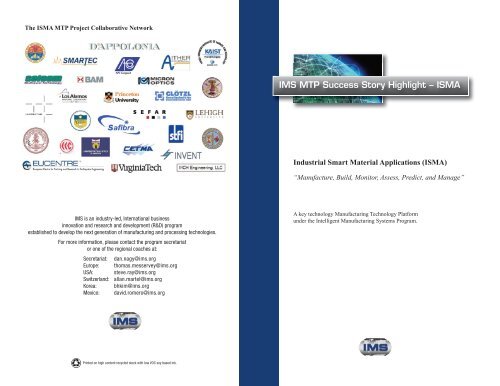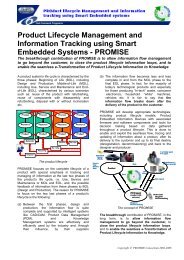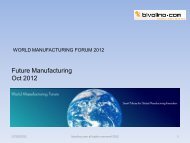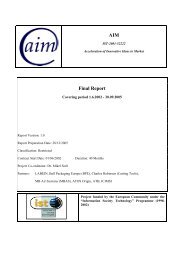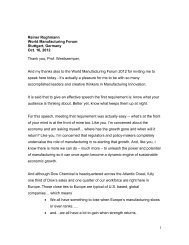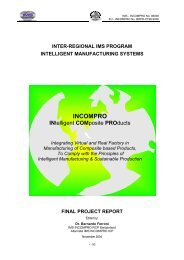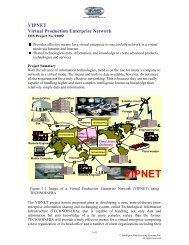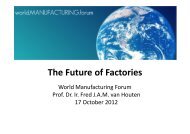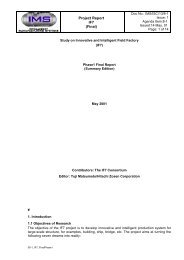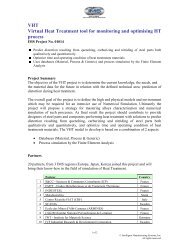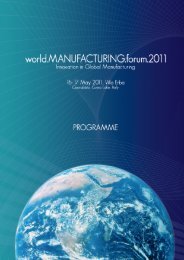ISMA Success Story - Intelligent Manufacturing Systems
ISMA Success Story - Intelligent Manufacturing Systems
ISMA Success Story - Intelligent Manufacturing Systems
Create successful ePaper yourself
Turn your PDF publications into a flip-book with our unique Google optimized e-Paper software.
The <strong>ISMA</strong> MTP Project Collaborative Network<br />
IMS MTP <strong>Success</strong> <strong>Story</strong> Highlight – <strong>ISMA</strong><br />
Industrial Smart Material Applications (<strong>ISMA</strong>)<br />
“Manufacture, Build, Monitor, Assess, Predict, and Manage”<br />
IMS is an industry-led, International business<br />
innovation and research and development (R&D) program<br />
established to develop the next generation of manufacturing and processing technologies.<br />
For more information, please contact the program secretariat<br />
or one of the regional coaches at:<br />
Secretariat: dan.nagy@ims.org<br />
Europe: thomas.messervey@ims.org<br />
USA: steve.ray@ims.org<br />
Switzerland: allan.martel@ims.org<br />
Korea: bhkim@ims.org<br />
Mexico: david.romero@ims.org<br />
A key technology <strong>Manufacturing</strong> Technology Platform<br />
under the <strong>Intelligent</strong> <strong>Manufacturing</strong> <strong>Systems</strong> Program.<br />
Printed on high content recycled stock with low VOC soy based ink.
<strong>ISMA</strong> Industrial Smart Material Applications<br />
Manufacture, Build, Monitor, Assess, Predict, and Manage<br />
MTP PROJECT MOTIVATION: Smart materials will be the building elements<br />
of tomorrow. These materials will employ sensors and actuators, will have communication<br />
capabilities, will contain self-healing agents, and other characteristics to<br />
make them multifunctional. As we progress toward this future, there are many challenges<br />
to identify and solve. Several include the integration of independent technologies<br />
into systems, the understanding and cooperation between multiple<br />
disciplines, the formulation of standards and guidelines, and the business case that<br />
convinces end users to adopt them.<br />
<strong>Manufacturing</strong>, education, standards, and key technologies are at the heart of what<br />
needs to be done and the challenges and opportunities associated with this work are<br />
international in nature. As such, the exchange of best practices and coordinated<br />
research efforts under the <strong>Intelligent</strong> <strong>Manufacturing</strong> <strong>Systems</strong> program is an excellent<br />
fit.<br />
Researcher Exchange and Job Placement<br />
Another unplanned and highly rewarding result of the <strong>ISMA</strong> MTP project has<br />
involved the exchange of young researchers and job placement. This occurred<br />
in 2009 when the University of Pavia,<br />
Italy was able to send PhD candidate<br />
Clemente Fuggini to the University of<br />
Illinois to participate in the Asia-<br />
Pacific Summer School on Smart<br />
Structures Technologies. Reciprocation<br />
occurred a year later when PhD<br />
candidate Fernando Moreu was<br />
invited to attend and be a part of the<br />
seismic experimentation being held at<br />
the EUCENTRE (located at the<br />
University of Pavia) under the coordination<br />
of D’Appolonia. To make the<br />
circle complete, Dr. Fuggini is now a<br />
project engineer with D’Appolonia.<br />
Employment was created.<br />
University of Pavia PhD candidate at the<br />
University of Illinois (top) and UI PhD<br />
candidate at the University of Pavia (bottom).<br />
<strong>Manufacturing</strong>, testing, and applications for smart materials from the underlying project<br />
POLYTECT led by <strong>ISMA</strong> MTP Project coordinator D’Appolonia S.p.A.<br />
Lessons Learned and Advice for forming MTP projects<br />
IMS can claim itself as the only multi-lateral manufacturing centric research platform<br />
worldwide. With over 14 years of experience and over 700 organisations that<br />
have worked within the IMS framework, becoming involved in IMS can open<br />
doors into new markets, solve technical challenges, address standards issues, and<br />
create networking possibilities that are otherwise difficult and expensive to come<br />
by. For <strong>ISMA</strong>, we created a low threat, “come as you are” MTP project. This has<br />
worked great as we continue to champion the adoption smart materials and the<br />
creation of an industrial market for smart material applications worldwide. We also<br />
benefitted from leaving our platform open to the addition of new partners. As word<br />
of our MTP project spread, we attracted the interest and experience of partners<br />
that have made a welcome addition and contribution.<br />
2 11
Connecting Companies and Solving Industrial Needs through Collaborative<br />
Research<br />
One of the most enjoyable aspects of the <strong>ISMA</strong> MTP project has been the ability to<br />
make connections between industrial or academic partners for the benefit of both.<br />
This was the case when Safibra (an instrumentation company specialised in fibre<br />
optics) had the opportunity to begin collaborating directly about its research interests<br />
with one of its principle suppliers, platform member Micron Optics. For Safibra,<br />
the benefit was that of a small Czech SME gaining international exposure and a<br />
direct feed into a much larger company. For Micron Optics, the benefit was the ability<br />
to better understand the needs of their client base and to gain insight into a potential<br />
international market for growth.<br />
A second example is when D’Appolonia in collaboration with <strong>ISMA</strong> platform member<br />
CETMA were looking for a way to increase the robustness of connections and junctions<br />
where linear fibre optic sensors exit from embedded smart materials. These<br />
egress points can be fragile and/or reduce the quality of measurement. After the<br />
issue was exposed during platform discussions, <strong>ISMA</strong> platform member University<br />
of Delaware offered a potential solution. In collaboration with the Army Research<br />
Laboratory (ARL), the University of Delaware has been working on non-contact<br />
data porting through fibre optic cables using angled mirrors and other techniques<br />
as shown in the accompanying figure. This same technique (e.g. non contact interrogation)<br />
may be a good solution for sensor-embedded composites.<br />
DESCRIPTION & OBJECTIVES: <strong>ISMA</strong> is a “Key Technology” <strong>Manufacturing</strong><br />
Technology Platform (MTP) project where smart materials are the key technology.<br />
Six keywords are associated with the title to provide the scope of the initiative.<br />
Manufacture: How do we manufacture durable materials with embedded sensors<br />
and communication technologies?<br />
Build: What construction processes or assembly procedures change or are required<br />
to support these new materials?<br />
Monitor: How should we pre-process, post-process, and manage the collected<br />
data?<br />
Assess: Given data, what does it tell us about the condition and health of that structure<br />
or machine?<br />
Predict: How can assessments through time be carried forward to predict future<br />
status.<br />
Manage: Given predictions, what repair and maintenance actions should be taken<br />
to extend the service life with an optimal use of resources?<br />
To begin to answer these questions and to address these challenges, D’Appolonia<br />
S.p.A. created <strong>ISMA</strong>, an international consortium of over 30 experts from industry,<br />
academia, and research centres representing the civil infrastructure, aerospace,<br />
maritime, automotive, and transport industries. For D’Appolonia, the platform is<br />
strategic in that these industries align closely with its core consultation activities,<br />
and new knowledge, products, and services will make its offerings more competitive.<br />
For other IMSA industrial partners, the <strong>ISMA</strong> platform provides international<br />
exposure and the opportunity to interact with researchers working on similar challenges<br />
worldwide. For academic and research partners, <strong>ISMA</strong> provides the opportunity<br />
to get closer to industry and to identify the needs of the market. With this<br />
background, the goal of <strong>ISMA</strong> is to share and create new knowledge in the<br />
following objective areas:<br />
• Identification of exploitable industrial applications for sensor embedded materials,<br />
acquisition systems, and management software where structural health monitoring<br />
and life-cycle management are both desirable, feasible, and cost effective.<br />
• Development of rugged sensing technologies, able to withstand industrial manufacturing,<br />
construction demands, and environmental conditions over long periods of time.<br />
• Development of affordable, robust, and simple to use data acquisition systems.<br />
• Integration of sensing and communication technologies into materials such as technical<br />
textiles, smart concrete/mortar, smart composites, and others.<br />
• Development of SHM algorithms and data interpretation methods specific to the<br />
targeted application.<br />
• Development of guidelines and standards for the deployment, use, and assessment<br />
of smart materials.<br />
10<br />
3
LINKED PROJECTS: Below, a sample listing of projects linked by the <strong>ISMA</strong><br />
platform is provided. Because <strong>ISMA</strong> has formed a network of high quality companies<br />
and research institutions working in this topic area, it is space prohibitive to list the<br />
collective expertise of the network. However, the following ongoing large-scale<br />
projects can be highlighted as examples of project knowledge sharing and the topic<br />
areas being investigated.<br />
POLYTECT “Polyfunctional Technical Textiles against Natural Hazards”<br />
A European FP6 project (www.polytect.net) dealing with sensor-embedded<br />
construction textiles.<br />
PROETEX “Protection e-Textiles”<br />
Micro/Nanostructured fibre systems for Emergency-Disaster Wear,” a European<br />
FP6 project (www.proetex.org) dealing with embedding intelligence into firefighter<br />
uniforms.<br />
OFSETH “Optical Fibre Sensors Embedded into technical Textiles for Healthcare<br />
Monitoring”<br />
A European FP6 project (www.ofseth.org) dealing with smart medical textiles with<br />
integrated FOS for medical purposes.<br />
Although WALL-EE was not successful, POLYMAST was successful and it<br />
brought with it the expertise and facilities of the EUCENTRE located in Pavia,<br />
Italy to the <strong>ISMA</strong> platform. This new research effort enabled the partially funded<br />
conduct of a full-scale seismic test at the EUCENTRE on a damaged masonry<br />
building repaired and reinforced with sensor-embedded seismic wallpaper<br />
produced by <strong>ISMA</strong> industrial platform members D’Appolonia, SELCOM, Safibra,<br />
and Light Structures with the support of the Karlsruhe Institute of Technology, the<br />
Saxon Textile Research Institute (STFI), and Consortia CETMA.<br />
The experiment was the first of its kind worldwide, was covered by two television<br />
programs, and produced excellent results (e.g. the structure was more resistant and<br />
safe against seismic forces and the sensor-embedded textiles were able to detect<br />
motion and detect damage). Moreover, this was the first opportunity that the<br />
industrial partners had to test and evaluate their product on a full-scale structure<br />
subjected to realistic ground motions.<br />
MAMAS “Advanced multi-functional materials for structural applications in Civil<br />
Engineering”<br />
Project funded by the Italian Government.<br />
MOSES “Innovative continuum Mulitplex Optical Sensors hull stress monitoring<br />
system, supporting shipping safety and Enhancing the control capability over<br />
structural Ship integrity”<br />
A European FP7 project (www.mosesproject.eu) dealing with the structural health<br />
monitoring of ship hulls.<br />
NSF I/UCRC TIE PROJECT<br />
“Assessment and validation of prognostic structural health monitoring prior and<br />
after bridge rehabilitation”<br />
A project funded by the National Science Foundation in the United States for the<br />
monitoring supported investigation of Grove Island Bridge, Florida, USA.<br />
TIP AWARD 70NANB9H9007<br />
“Self-Powered Wireless Sensor Network for Structural Bridge Health Prognosis”<br />
A program funded by US research dealing with the structural health monitoring of<br />
bridges.<br />
Evaluating sensor-embedded “seismic wallpaper” as part of the <strong>ISMA</strong> platform<br />
in collaboration with the EUCENTRE as part of the SERIES program<br />
4<br />
9
The conference was organised by <strong>ISMA</strong> platform member Prof. Dan Frangopol of<br />
Lehigh University who is a founding member of IABMAS, the Journal of Structure<br />
and Infrastructure Engineering, and holds an Endowed Chair at Lehigh.<br />
Example papers at this special session included conference included “Optimal design<br />
of SHM systems based on risk and opportunity analysis” presented by Dr. Inaudi<br />
of SMARTEC (CH), “Streiker Bridge: initial evaluation of LCC benefits of various<br />
structural health monitoring approaches” presented by Prof. Branko Glisic of<br />
Princeton (USA), and “Conical couplers for non-pigtailed, free-space optical<br />
coupling to fiber optic sensors for bridge monitoring” presented by Dr. L. Qui of<br />
the University of Delaware (USA).<br />
HIGHLIGHTED PLATFORM ACTIVITIES:<br />
Newsletters – Sharing Company Interests and Activities<br />
One of the advantages of an IMS MTP Project is its flexibility. Activities, meetings,<br />
and IPR can be arranged to best suit the needs of consortium members and the<br />
area of research. As with any network, once partners begin to exchange ideas and<br />
experiences, they often find a surprising amount of shared interests and opportunities<br />
for collaboration. This has certainly been the case for many of the <strong>ISMA</strong><br />
platform members.<br />
New Collaborations & Opportunities for Research<br />
Although conference special sessions set the baseline for the platform, <strong>ISMA</strong><br />
activities went far beyond presentations and in one case, directly onto a seismic<br />
shaking table. Possibly the highlight of the <strong>ISMA</strong> MTP project occurred when two<br />
of its projects (POLYTECT and PROETEX) linked to combine knowledge and<br />
available resources. The result was a research proposal called POLYMAST to the<br />
FP7 SERIES program for use of a European seismic testing centre and a research<br />
proposal submitted under the Framework Programme 7 (FP7) Information<br />
Communication Technologies (ICT) domain called WALL-EE which focused on<br />
several of the research needs identified by IMSA platform experts in the kickoff<br />
survey.<br />
In this spirit, beginning even 6 months before the official <strong>ISMA</strong> kickoff, the platform<br />
initiated a quarterly newsletter to share information and to begin to organise<br />
project activities. This newsletter provided the additional benefit of attracting new<br />
partners and was used to help plan the first series of meetings at conference special<br />
sessions.<br />
Conference Special Sessions – Bringing Industry to the Forefront<br />
<strong>ISMA</strong> has used conference special sessions as the mechanism for platform meetings.<br />
This has served to maximize the use of resources, to further publicise the platform,<br />
and to take advantage of events that consortium partners were organising or already<br />
planning to attend.<br />
8<br />
5
1st<br />
The first such session (and <strong>ISMA</strong> kickoff) was held at the 7th International Workshop<br />
on Structural Health Monitoring (IWSHM09) 9-11 September, 2009, held at<br />
Stanford, California. Perhaps the leading health monitoring conference worldwide,<br />
IWSHM occurs every two years and is organised by <strong>ISMA</strong> consortium partner Prof.<br />
Fu-Kuo Chang who serves as the director of the Structures and Composites Laboratory<br />
at Stanford University. At IWSHM09, the <strong>ISMA</strong> platform conducted two<br />
special sessions (12 papers) representing approximately 6% of the conference.<br />
Example paper topics included “The development and testing of Carbon Fibre Reinforced<br />
Polymer (CFRP) rods for Structural Health Monitoring” presented by Dr.<br />
Paolo Corvaglia of CETMA (EU), “Self Powered Wireless Sensor Network for<br />
Structural Bridge Health Prognosis: a 5-year R&D project for Infrastructure<br />
Sustainability” presented by Dr. Fabio Matta of the University of Miami (USA),<br />
and “Integrated Structural Health Monitoring <strong>Systems</strong> for Buildings” presented by<br />
Daniele Inaudi of SMARTEC (CH). Also at the kickoff, a survey was conducted<br />
to query platform experts on the prioritization of research efforts in the field of<br />
smart materials.<br />
2nd<br />
The second <strong>ISMA</strong> meeting and organisation of conference special sessions<br />
occurred 29 Jun 2010 – 2 July 2010 at the 5th European Workshop on Structural<br />
Health Monitoring (EWSHM 10) held in Sorrento, Italy. The conference was<br />
organised by <strong>ISMA</strong> platform member Prof. Fabio Casciati from the University of<br />
Pavia, Italy.<br />
At this workshop, <strong>ISMA</strong> contributed 17 papers across 4 sessions representing<br />
approximately 9% of conference<br />
presentations. This<br />
is notable because as an<br />
IMS MTP project, <strong>ISMA</strong> is<br />
industry led and international<br />
in nature. Capturing<br />
nearly 10% of a leading<br />
international conference in<br />
the topic area of interest<br />
was a landmark success.<br />
Example paper titles included “Sensor-Embedded Textiles for the Reinforcement,<br />
Dynamic Characterisation, and Structural Health Monitoring of Masonry Structures”<br />
presented by Dr. Tom Messervey and Dr. Clemente Fuggini of D’Appolonia<br />
S.p.A. (EU), “A Wavefield Imaging Technique for Delamination Detection in<br />
Composite Structures” presented by Prof. Hoon Sohn of KAIST (Korea), and<br />
“Carbon Nanosensors for Health Monitoring of PZT Bondline during Curing and<br />
its In-Service Life” presented by Prof. Chang of Stanford (USA).<br />
3rd<br />
The third and most recent <strong>ISMA</strong> meeting and special session was held at the 5th<br />
International Conference on Bridge Maintenance, Safety, and Management<br />
(IAMBAS 2010), held 11-15 July, 2010 in Philadelphia, Pennsylvania, USA.<br />
Leading the list of sub-topics for priority effort was the Linkage of SHM to Maintenance<br />
and Reliability and the Integration of ICT Technologies into <strong>Systems</strong> (e.g.<br />
networks of sensors positioned on structures to provide meaningful information).<br />
6 7


